If you ask any seasoned chef or acclaimed restaurateur, they’ll likely agree that securing a Michelin Star is one of the most prestigious accolades in the culinary world. This ranking system started at the turn of the 20th century—evaluating select restaurants’ quality of product, mastery of flavor and cooking techniques, the value of money, and more to obtain one to three stars.
Then, in 2020, Michelin announced a brand new Green Star category, recognizing leading sustainable restaurants with exemplary eco-friendly commitments. Let’s take a look at the top Michelin Green Star restaurants in the U.S. today.
What Is a Michelin Green Star?
The Michelin Green Star is awarded every year to restaurants that uphold outstanding sustainable and eco-friendly culinary practices. These restaurants aim to reduce waste throughout every step of the supply chain and work directly with suppliers and vendors striving to do the same. Many collaborate with farmers and growers who practice regenerative farming—ensuring they use the freshest and most seasonal ingredients. They also put philanthropy at the forefront, contributing to charities that also address well-being and ethics.
Michelin Green Star Rating Criteria
How Restaurants are Evaluated:
1. Origin of the ingredients and use of seasonal produce
2. Environmental footprint
3. Food waste systems and recycling
4. Resource management
5. Communication of the restaurant’s sustainable approach to guests
Most Sustainable Michelin Green Star Restaurants in the U.S.
There are currently 291 Michelin Green Star restaurants in the world and a handful in the U.S. Let’s take a look at the top sustainable restaurants in America.
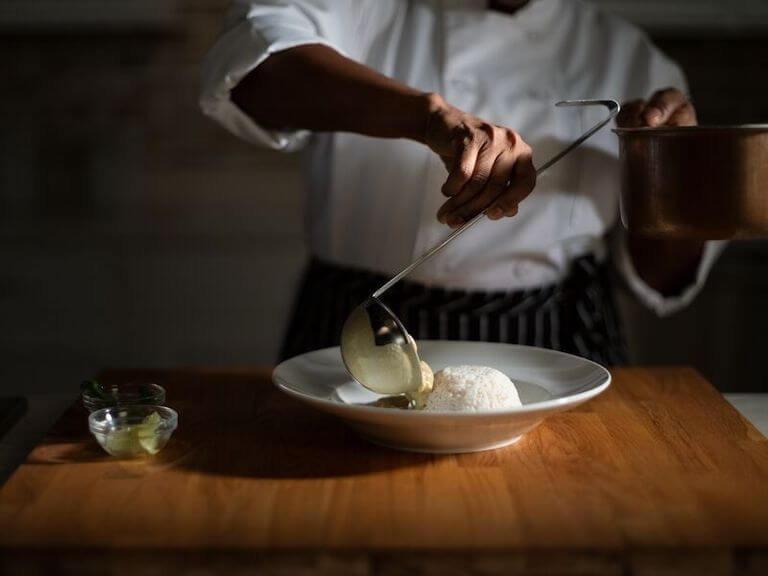
1. Atelier Crenn
Situated between Marina District and Pacific Heights in San Francisco, the 3-star Michelin restaurant and Green Star recipient, Atelier Crenn, is the result of Chef Dominique Crenn’s evolutionary journey as a revered culinarian. Atelier Crenn’s distinct eco-friendly concept nods to California’s radiant coastline and surplus of plants, fish, and native ingredients.
In fact, Crenn only partners with local farmers who instill biodynamic practices, and the entire menu is meat-free. Also, any produce waste is composted right at Crenn’s farm—Bleu Belle Farm—a regenerative agriculture hub and participant in California’s Native Plant program.
2. The French Laundry
Referenced as Chef Thomas Keller’s masterpiece and the “greatest cooking space in America,” The French Laundry, based in Yountville, California, is one of the only restaurants to highlight fine French cuisine in Napa Valley. The menu rotates on a daily basis and a culinary gardener harvests all products featured, underscoring its commitment to only incorporating the most high-quality ingredients.
Guests can indulge in delectable dishes like applewood smoked Wolfe ranch white quail that elegantly showcases creamed garden Swiss chard, Watsonville artichokes, and crispy chickpea panisse. When it comes to sustainability, French Laundry is equipped with a solar and battery system, and the siding is treated with the Japanese “shou sugi ban” technique, which can reduce the requirement for toxic weatherproofing.
3. Single Thread
Single Thread is a Farm-Restaurant-Inn nestled right in downtown Healdsburg, just north of Santa Rosa, California. Chef Kyle Connaughton and his wife Katina Connaughton conceptualize innovative dishes that revolve around “kaiseki-influenced” cuisine, inspired by their Japanese travels. The couple also offers guests innovative “botanical” menu selections and ingredients that derive right from their five-acre organic farm—making it possible to grow 70% of their produce without the use of municipal water.
On top of this, the farm boasts more than a hundred olive trees that yield all the olive oil utilized, while every single floral component employed in the certified LEED dining room is either sourced from their farm or collected from the nearby woodland.
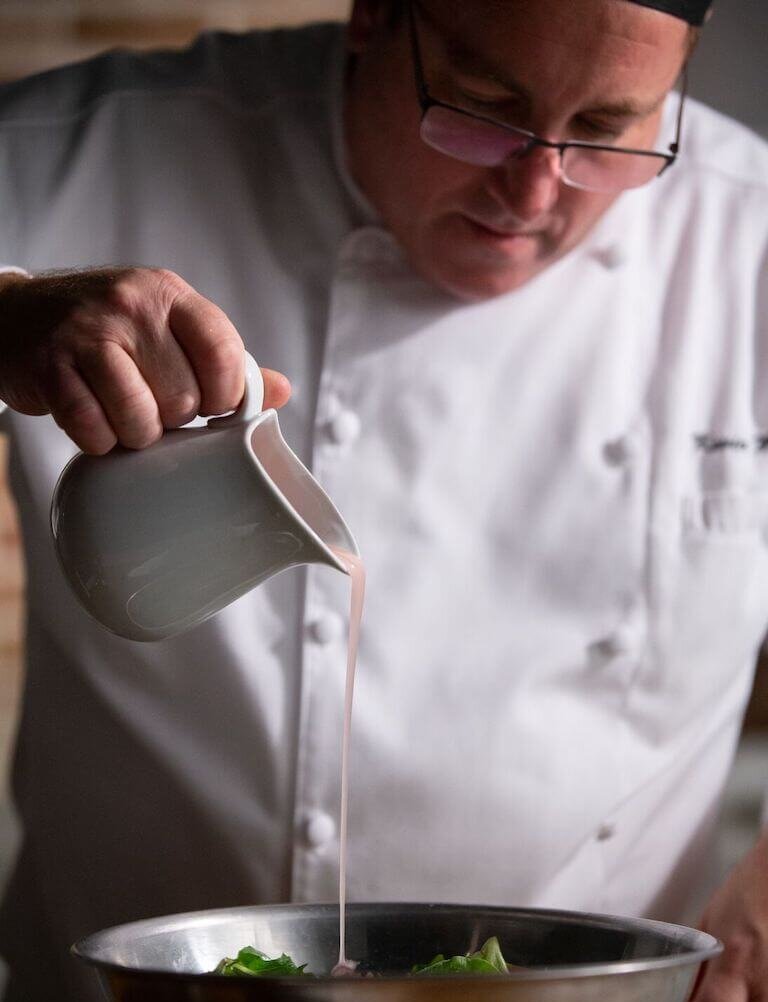
4. The Inn at Little Washington
The dining experience at The Inn at Little Washington is situated just 90 minutes outside of D.C. and is described as a “whimsical culinary arts performance.” For over 43 years, Chef Patrick O’Connell has intentionally designed the menu to highlight eclectic vegetarian dishes that incorporate indigenous ingredients from local farmers.
The Inn also owns a private garden, which ensures it can always source the freshest herbs and produce, while even supplying its own honey from hives on the property. Guests can choose from “The Gastronaut” or “The Good Earth” menus, featuring dishes like glazed sesame-crusted tofu on cucumber noodles with marinated garden radishes and cucumber sorbet.
5. Harbor House
Tucked in between the luscious Redwood forests and the Pacific coastline of Mendocino County, Harbor House only employs sustainable cooking practices under the directive of Chef Matthew Kammerer. The menu features locally foraged ingredients like flavorful mushrooms, untainted seaweed, and aromatic herbs.
Harbor House also places special emphasis on utilizing natural sources of heat through steam and fire to amplify the natural taste of ingredients. Aside from these sustainable practices, Chef Kammerer maintains a chicken coop on-site, supplying eggs and composts for the restaurant’s on-site gardens.
6. Blue Hill at Stone Barns
Blue Hill at Stone Barns offers a high-end farm-to-table dining experience in Pocantico Hills, New York. With the help of culinarian Dan Barber, Blue Hill remains a pioneer in zero-waste philosophy for restaurants, partnering with grain and vegetable breeders to offer “low-input” varieties of ingredients.
The restaurant also collaborates with 64 local farmers, and 80% of seafood purchases come from Long Island day boat fishermen. Guests can anticipate a sensorial feast that highlights the distinct, native ingredients that come from the Hudson Valley.
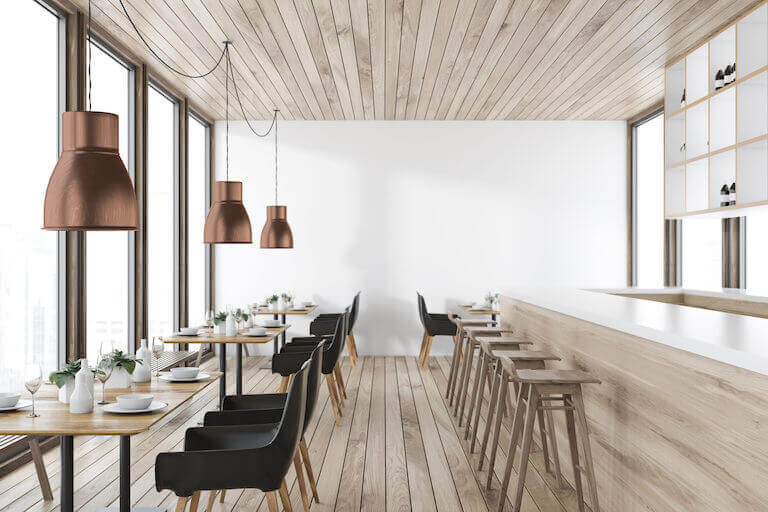
Interior dining area of a sustainable restaurant.
7. Le Comptoir at Bar Crenn
Viewed as Atelier Crenn’s little sister with a smaller price tag, Le Comptoir brands itself as a “Japanese-style listening bar.” Like Atelier Crenn, this intimate dining hall instills the same sustainable practices, while offering a meat-free menu.
During this two-hour experience, guests can indulge in fresh seafood and vegetable-focused dishes, with a choice of two beverage pairings.
8. The Restaurant at JUSTIN
For wine connoisseurs who indulge in the wine-tasting experience at Justin Winery in Paso Robles, California, they can conveniently choose to dine at The Restaurant at JUSTIN. This elegant eatery is the only winery in the U.S. with a Michelin star and Green Star.
Diners can expect to feast on a multi-course dinner menu, featuring seasonal ingredients sourced straight from its own 26-acre farmstead. According to Chef Rachel Haggstrom, the farm is peppered with bustling edible flower fields, an apiary, and a thriving 150-tree orchard.
9. Osteria Mozza
Revered Chef Nancy Silverton is the culinary creator of Osteria Mozza—an upscale Italian restaurant in Los Angeles, California. The real highlight is the glorified, Carrara marble Mozzarella Bar, where Chef Silverton ideates one-of-a-kind dishes with imported ricotta, cream-filled burrata, and mozzarella.
This culinary attraction secured a Michelin Green Star due to its unwavering dedication to buying organic ingredients from local farmers. Osteria Mozza also hired a third-party company to strategize and execute ways to reduce its carbon footprint, reconfigure its internal waste management system, and use only eco-friendly products.
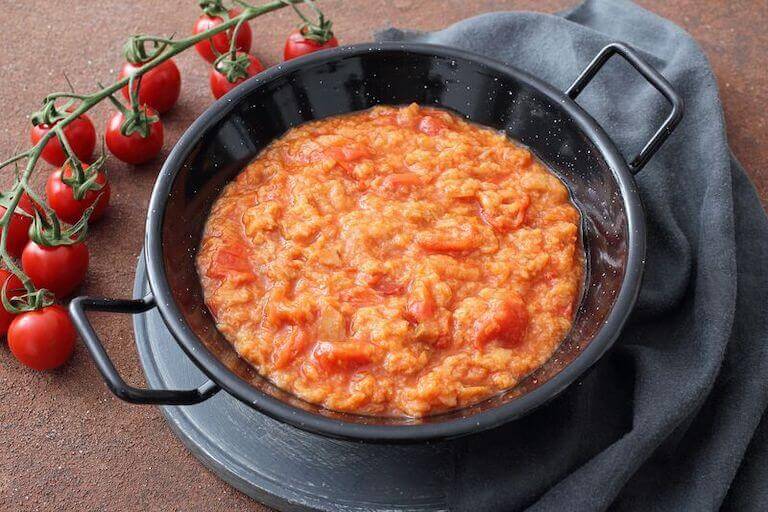
Fresh Pappa al Pomodoro made with organic ingredients.
10. Caruso’s
Established in the classy Rosewood Miramar Beach Resort is Caruso’s—a fine-dining oceanfront restaurant that takes pride in its California Central Coast cuisine, while also honoring Italian heritage. Each menu item celebrates a long history of partnerships with local farmers, ranchers, and fishers, bolstering the belief in preserving the Pacific Ocean. In fact, 90% of the seafood is local and sourced sustainably.
Caruso’s expansive Garde Manager program is also fueled by the restaurant’s garden and on-site beehives to source the purest honey. Menu items range from minted chilled spring pea soup with pickled fennel to Santa Barbara bluefin ahi tartare, and everything in between.
11. Chez Panisse
Deemed as the original thought leader of farm-to-table cuisine, Alice Water’s legendary Chez Panisse remains an iconic eatery in Berkeley, California. The nightly fixed menu boasts four rotating courses—all highlighting seasonal organic ingredients, with 75% of produce coming straight from the restaurant farm. Chez Panisse also promotes zero landfill waste as part of its value proposition.
From a warm asparagus and leek salad with wild rocket and mustard blossoms to northern halibut with fava bean–preserved lemon salsa and spinach, Chez Panisse’s environment-first approach to culinary arts sets the bar high for sustainable restaurants.
12. Chi Spacca
Chi Spacca is another popular Michelin Green Star Restaurant by Chef Nancy Silverton, tucked away in sunny Los Angeles, California. Guests can expect an inviting dining experience that reflects “how an Italian butcher might cook” by reinventing the old-school steakhouse and celebrating the Italian salumi culture.
The current menu offers a modern Italian twist with classic, seasonal items like grilled calamari with spicy romesco or juicy pepper steak with crispy bacon and scallions. What sets Chi Spacca apart from other sustainable eateries is its “ode to beautiful meat” by using fire and smoke from wood-burning ovens. Just like Osteria Mozza, Chi Spacca also aims to reduce waste in every step of the food-to-table process.
“Farm-to-table practices and sustainability are very important in the food and wine world. It’s about allowing the chef to get the best product within hours out of the ground which is important.”*
Chef Curtis Duffy, Escoffier Partner, and 3 Michelin Star Restaurant Chef & Owner
Elevate Your Sustainable Culinary Skills
Whether you strive to become a chef who earns a Michelin Green Star at sustainable restaurants or conceptualizes dishes with an eco-friendly mindset, the first step may be to build a solid educational foundation.
Every student who enrolls in Escoffier’s Culinary Arts programs can start to explore basic techniques, classic kitchen terminology, knife skills, and more. Aspiring chefs enrolled in this program can also take a deep dive into The Farm to Table Kitchen, which examines progressive sourcing methods and ways to cook with organic, sustainable ingredients.
Talk to our admissions department to discover how this curriculum can help you reach your culinary career goals!
Enjoyed this sustainability article? Check out these next:
- What is “Carbon Neutral” and Why Does it Matter in the Food Industry?
- What is Holistic Nutrition & Wellness?
- How to Start a Career in Holistic Health
*Information may not reflect every student’s experience. Results and outcomes may be based on several factors, such as geographical region or previous experience.

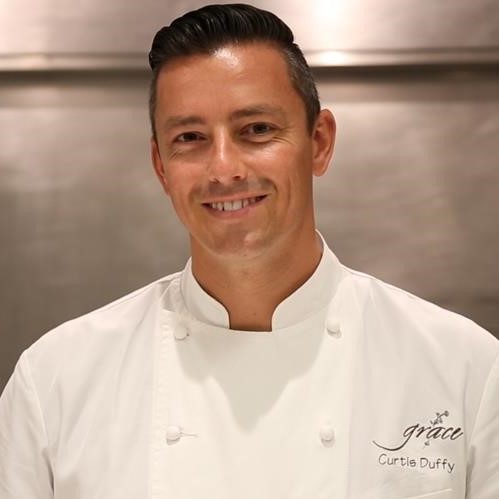 “Farm-to-table practices and sustainability are very important in the food and wine world. It’s about allowing the chef to get the best product within hours out of the ground which is important.”*
“Farm-to-table practices and sustainability are very important in the food and wine world. It’s about allowing the chef to get the best product within hours out of the ground which is important.”*